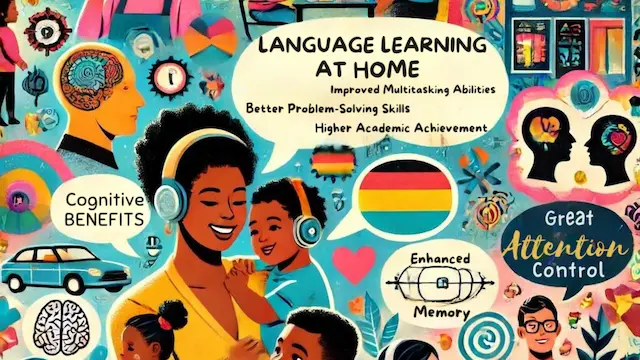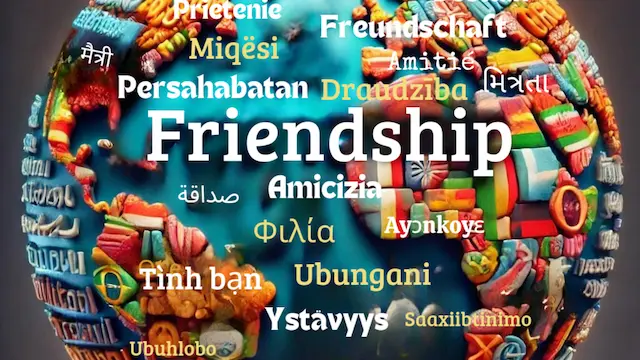Language Learning at Home: 10 Helpful Bilingual and Trilingual Tips

Are you teaching your child to become bilingual or trilingual or interested in learning a new language?
Language learning at home can be a fun and rewarding experience for both children and adults.
Not only does it provide the gift of languages, but it also strengthens cognitive abilities, which are mental skills essential for everyday learning, and opens up opportunities for cultural exchange.
For bilingual children, learning a second language can be a valuable asset in today's globalized world.

It not only strengthens communication skills but also promotes cultural awareness and understanding.
Trilingual kids have an even greater advantage as they can communicate with people from three different cultures and gain a wider perspective on the world.
Home language is also an important aspect of language learning. It is essential to maintain and develop the language spoken at home in order to preserve cultural identity and heritage.
Whether you are a parent teaching your child a new language or an adult learning a new language for personal or professional growth, learning a language can be a fulfilling experience.
The Importance of Language Learning at Home for Bilingual and Trilingual Families

As a bilingual or trilingual family, you have a unique opportunity to provide your children with the advantage of language proficiency.
Language learning in your home not only strengthens your children's cognitive abilities but also provides them with social and cultural benefits that can last a lifetime.
Cognitive Benefits of Language Learning at Home
Research has shown that bilingual and trilingual individuals have improved cognitive abilities, such as better problem-solving skills, enhanced memory, and increased creativity.
Learning multiple languages also helps children develop better multitasking abilities and improve their overall academic performance. Specifically, these cognitive benefits include:
- Memory: The ability to store and recall information.
- Attention: The capacity to focus and maintain concentration.
- Perception: The ability to interpret sensory information.
- Problem-Solving: The ability to find solutions to challenges.
- Language Skills: The ability to understand and use language.
- Logical Reasoning: The capacity to analyze information and make decisions.
Social Benefits of Language Learning at Home
Language learning can also provide social benefits for your children. Bilingual and trilingual individuals can communicate with a wider range of people, often leading to new friendships and opportunities.
Additionally, children who learn multiple languages at home often develop better communication skills and greater empathy.
When you travel to your home country with your kids, they can feel isolated if they don't understand the language, and you end up having to translate everything for them.

I have fond memories of being able to speak and communicate with my grandparents who primarily spoke Twi.
Although I wasn't fluent, knowing the basics helped me and my siblings connect with our grandparents and other family members in Ghana.
It has also become a funny party trick for our youngest. When she gets commended for knowing some Twi words, she comes up to one of us and asks, “Abɔ sɛn?” which means “What time is it?” This often earns her another pat on the back. It's sweet to watch them take pride in what they have learned and share that pride.
Funny enough, “saat kaç?” meaning “What time is it?” in Turkish is a phrase I still share as my own “party trick” when meeting Turkish language speakers.
Cultural Benefits of Language Learning at Home
Learning multiple languages at home also provides your children with a deeper understanding and appreciation of different cultures.
As they learn about different languages and cultures, they will develop a broader perspective of the world around them.
This can help them to become more open-minded and accepting of diversity.

Native Language
For bilingual and trilingual families, preserving the native language(s) at home is important.
This practice helps children maintain their cultural identity, strengthens their connection to their heritage, and provides a strong foundation for learning additional languages in the future by understanding and appreciating cultural roots and family traditions.
Native Language vs. First Language
- Native Language: The language a person has been exposed to from birth or within the critical period for language acquisition.
- First Language: The first language a person learns to speak. It is also the language a person is most comfortable with and proficient in.
I was born to Twi-speaking parents in Germany. Twi was my native language due to our home environment.
However, I learned German as my first language because of the surrounding environment and educational system, which was also the language I felt more comfortable with.
In my case, Twi helped maintain my cultural identity, while German was used for daily communication and education.
Understanding the difference between native and first language is interesting and important in recognizing the roles these languages play in a person's life.
Native languages preserve cultural heritage, while first languages often determine a person's primary mode of communication and learning.

Wondering how to introduce your kids to different cultures and languages in a fun, engaging way?
Learning about the world doesn't have to feel like another task – it can be an exciting adventure for the whole family.
Second Language
In addition to preserving the native language(s), learning a second language at home provides children with the opportunity to become bilingual.
This can lead to improved cognitive development and better communication skills.
Bilingual children often excel in problem-solving and multitasking and show greater empathy.
Benefits of Learning a Second Language at Home
- Cognitive Development: Enhances memory, attention, and problem-solving skills.
- Communication Skills: Improves the ability to understand and use language effectively.
- Cultural Awareness: Exposes children to new cultures and perspectives.
- Academic Performance: Bilingual children often perform better academically.
Practical Tips for Learning a Second Language at Home
- Start Early: Introduce multiple languages as early as possible to take advantage of children's natural language acquisition abilities.
- Consistent Exposure: Ensure regular exposure to each language through daily routines and activities.
- Designated Language Days: Allocate specific days for speaking each language to create a balanced learning environment.
- Interactive Resources: Utilize language learning digital printables, apps, books, and games to make learning fun and engaging.
- Cultural Immersion: Engage with media (music, films, books) in the target languages and participate in cultural activities.
- Family Involvement: Encourage all family members to speak their native language around the child to reinforce learning.
- Language Exchange: Connect with native speakers online or participate in language exchange programs.
- Travel: If possible, travel to countries where the target languages are spoken to provide immersive experiences.
- Create a Language-Rich Environment: Label household items in different languages and incorporate language learning into daily activities.
- Celebrate Progress: Regularly acknowledge and celebrate your child's language learning milestones to keep them motivated and confident.
In my case, adding English takes it to a third language, making me trilingual. This combination has given me the opportunity to communicate effectively in multiple languages and interact with diverse cultural perspectives.
I know this is a privilege and we hope to pass this on to our children as well.

Foreign Language
Learning a foreign language at home can also provide children with many unique benefits.
Beyond cognitive development and communication skills, it can broaden their global perspective and boost their future career opportunities.
Benefits of Learning a Foreign Language
- Global Perspective: Helps children appreciate and understand global cultures and issues.
- Career Opportunities: Bilingualism can be a valuable asset in the global job market.
- Travel Experiences: Enhances travel experiences by enabling communication with locals and understanding cultural nuances.
Practical Tips for Learning a Foreign Language at Home
- Language Exchange: Participate in language exchange programs or connect with native speakers online.
- Cultural Activities: Explore cultural activities such as cooking international recipes, celebrating global festivals, and learning about different countries.
- Advanced Resources: Utilize advanced language learning platforms, online courses, and virtual reality tools to simulate immersive experiences.
For me, English is a third language and not a foreign language because Ghana, my family's country of origin, was colonized by the British, and therefore the official language there is English.
As a result, English was widely incorporated into our home. My parents intentionally spoke English at home and provided access to English books and resources while I was growing up in Germany.
We traveled, and they made sure we interacted with English-speaking family members.
This deliberate exposure helped me become proficient in English alongside Twi and German. Personally, the concept of a foreign language came into play when I took French in school, which added another layer to my multilingual experience.
Although managing multiple languages might seem overwhelming, for the most part, it never felt like a task to me.
It felt natural because language learning was always presented as a part of our daily life and interactions.
How do you incorporate language learning into your daily life? Do you have any tips or experiences to share about learning multiple languages? We’d love to hear your thoughts and stories in the comments!
Creating a Language-Rich Environment at Home
Creating a language-rich environment at home is essential for developing language skills in bilingual and trilingual families.
Speech-language pathologists often recommend early exposure and regular practice, as seen in successful families who use methods such as designated language days and language immersion programs.
This approach not only helps children build their language skills but also strengthens their connection to their cultural roots.

Incorporating Multiple Languages into Daily Routines
One practical way to incorporate multiple languages into your daily routine is by labeling items around your home in different languages.
This helps you and your family members learn new vocabulary and reinforces language skills.
We always have products from Germany that we either brought back from our travels or received as gifts, with German labeling.
This way, the kids naturally pick up some words by seeing them often and asking about their translation.
Another effective method is setting aside specific times for language practice. This dedicated time ensures consistent exposure and helps build a routine for language learning.
Additionally, you can incorporate language learning into daily activities such as cooking, where you can use recipes in different languages, or during playtime with language-based games.
Engaging in cultural activities, such as watching films or listening to music in the target languages, can also make language learning more natural and enjoyable for the entire family.
Benefits of a Language-Rich Environment
- Enhanced Vocabulary: Exposure to diverse vocabulary in different contexts.
- Improved Communication Skills: Encourages the use of language in various situations.
- Cultural Awareness: Integrates cultural elements through language.
Practical Tips for Creating a Language-Rich Environment
- Daily Conversations: Speak the native and second languages regularly at home. For example, one parent might always speak the minority language (such as Twi or German) to the child, while the other parent uses the majority language (such as English).
- Reading Together: Incorporate books in multiple languages into your daily reading routine.
- Language-Based Games: Use games and activities that promote language use and learning.
- Multimedia Resources: Utilize music, movies, and apps in different languages.
- Cultural Activities: Engage in cultural events, cook traditional recipes, and celebrate festivals that use the target languages.
Utilizing Resources for Bilingual and Trilingual Language Learning
There are many resources available for learning a language at home, including books, apps, and online resources. Here are some examples:
- Books: Look for books in different languages at your local library or bookstore. You can also find free resources online in different languages.
- Apps: There are many free language learning apps available, such as Duolingo, Rosetta Stone, and Babbel. These apps offer interactive lessons and activities to help you learn new vocabulary and grammar.
- Online resources: There are many online resources available for language learning, such as language exchange websites and online courses. Some websites offer free language learning resources, while others require a subscription.

By utilizing resources for language learning, you can create a language-rich environment at home that will help you and your family members learn new languages and reinforce language skills.
Effective Strategies for Teaching Languages at Home
Learning a new language can be challenging without effective strategies in place. Let's explore some effective strategies to help you teach languages at home.
Consistency and Routine in Language Learning
Set aside a specific time each day for language practice and stick to it. This will help create a habit and make learning a language a regular part of your daily routine.
Another effective way to incorporate language learning into your routine is by using language support such as flashcards, books, and videos.
These supports can be used during designated language learning time or throughout the day to reinforce language skills.

Mixing Languages: When and How to Do It
Mixing languages, or code-switching, can be a helpful tool in language learning. However, it is important to use it strategically.
For some, mixing languages too often can lead to confusion and hinder language development.
Growing up, I often couldn't remember in which language I had responded, and it's funny to see how our kids are the same.
Yes, it can get confusing, but we keep at it because we have seen an improvement in the kids distinguishing between English, Twi, and German.
One effective way to mix languages is by using the mother tongue to explain new vocabulary or concepts.
This can help bridge the gap between the new language and the learner's existing knowledge.

Another way to mix languages is by incorporating them into playful activities, such as singing songs or playing language games.
We made up a song with our firstborn: “Eins (One). Zwei (Two). Drei (Three), Baako (One). Mmienu (Two). Mmiɛnsa (Three).”
We might still struggle with the rest of the numbers in German and Twi, but that song has been passed down to all the kids, and if anything, those first three numbers are ingrained.
Remember, regular practice and exposure to the language are important to language learning.
Try to incorporate these strategies into your language learning routine to help you and your family become bilingual or trilingual.
Encouraging Active Language Use in Children
Creating Opportunities for Language Practice
One way to encourage active language use in children is to create opportunities for them to practice their language skills.
You can do this by engaging in activities that promote language learning, such as reading books, singing nursery rhymes, and playing games that involve language.
Reading books together is an excellent way to expose your child to new words and concepts.
You can ask your child questions about the story, encourage them to describe what they see in the pictures and help them learn new words.
Singing nursery rhymes is another great way to help your child develop their language skills.
Nursery rhymes are often repetitive and easy to remember, making them an excellent tool for building expressive vocabulary.
You can also encourage your child to sing along with you and practice their pronunciation.
Language Learning Through Play and Interaction
Play and interaction are essential for young children's language development.
You can create engaging activities that promote language learning, such as playing with toys that involve language, like puzzles or board games.
You can also encourage your child to interact with others in their language.
For example, you can arrange playdates with other children who speak the same language as your child or find practice settings, like language classes or cultural events, where your child can interact with others and practice their language skills.
Overcoming Challenges in Bilingual and Trilingual Language Learning at Home
Learning a new language can be a challenging task, especially when you are trying to learn two or three languages simultaneously.
However, with the right strategies and mindset, you can overcome these challenges and achieve your language learning goals.
Let's discuss some common challenges faced by bilingual and trilingual language learners at home and how to overcome them.
Addressing Language Confusion and Mixing
One of the biggest challenges that bilingual and trilingual language learners face is language confusion and mixing.
This happens when you are trying to learn two or more languages at the same time and end up mixing the words and grammar rules of different languages.
To address this challenge, you can try the following differentiation strategies:
- Set Language Boundaries: Allocate specific times or contexts for using each language. For example, speak one language during meals and another during playtime or certain activities.
- Engage with Native Speakers: Regularly interacting with native speakers can help solidify language skills and reduce mixing. Consider language exchange programs or community events.
- Language-Specific Media: Consume media (books, movies, music) in the target languages separately. Avoid mixing languages within the same media session to maintain clear boundaries.
- Create flashcards or posters with pictures and words in each language.
- Use language-specific labels for objects around the house.
Motivating Reluctant Language Learners
Another challenge that many bilingual and trilingual language learners face is a lack of motivation.
It can be difficult to stay motivated and engaged when learning a new language, especially if it is not your dominant language.
Often, frustration and discouragement set in, and peers may laugh at mistakes. This was the case for me; for the longest time, I stopped speaking Twi.

However, in my 40s, I now see it as, “You understand some, if not all, of what I am saying.
Get past the accent and pronunciation so we can work with that and try to converse as best as possible.” Here are some tips to help motivate reluctant language learners:
- Start with basic vocabulary and the first words that are relevant to their daily life.
- Use fun and engaging language learning apps, games, and videos.
- Encourage them to practice with a language exchange partner or tutor.
- Celebrate their progress and achievements to boost their confidence and motivation.
These strategies can help turn the language learning process into a more enjoyable and rewarding experience, making it easier to stay motivated and committed.
Remember, learning a new language takes time and practice. Be patient with yourself and your family members, and keep a positive attitude towards language learning.
With dedication, you can overcome any challenges and become fluent in multiple languages.
Supporting Multilingualism in Different Family Structures
Single-Parent and Extended Family Involvement
If you are a single parent or part of an extended family, you can still support your child's multilingualism.
Having more family members involved can be advantageous for language learning.
Encourage everyone to speak their native language around the child, and consider enlisting the help of family members who speak a different language, even if they are not part of the household.
This exposure can help your child develop language skills more quickly.
We've noticed that there are many obvious phrases and questions that we might not ask our kids daily, and they often forget them when not practicing.
For example, “What is your name?” or “How old are you?”. By involving more family members, these gaps can be filled, as others can help ask these questions and reinforce language use.
Our parents have done a good job of this, always starting conversations with the kids in Twi. The kids proudly reply with what they have remembered.
In addition, involve your child in cultural activities that celebrate their heritage. This can include attending cultural festivals, cooking traditional foods, and listening to music from their culture.
These activities can help your child feel more connected and confident, encouraging them to not only learn but also speak their native language.
Community and Cultural Engagement
Community involvement is also important for supporting multilingualism. Seek out community resources such as language classes or cultural events that can help your child develop their language skills.
Encourage your child to interact with people from different cultures and backgrounds, and expose them to different languages through books, music, and movies.
Cultural engagement can also be a great way to support multilingualism. Learning about different cultures can help your child understand the importance of language and communication, and can motivate them to continue learning.
Consider taking your child to museums or cultural centers, or reading books about different cultures together.
By involving your family and community in your child's language learning journey, you can create a supportive environment that encourages multilingualism.
Remember to celebrate your child's progress and be patient as they develop their language skills.
With your support, your child can become a confident and skilled multilingual speaker.
Real-Life Success Stories of Bilingual and Trilingual Families
If you're considering raising your child to be bilingual or trilingual, it's always helpful to hear from those who have successfully done so.
Here are a few real-life success stories from multilingual families:

Great Examples of Families Incorporating Language Learning
Maria and Juan: Maria and Juan are a trilingual family who speak Spanish, English, and French at home. They credit their success to consistency and immersion. They speak only in their target languages to their children, and they make sure to expose them to the languages through books, music, and media.
Sophie and Tom: Sophie and Tom are a bilingual family who speak English and Mandarin Chinese at home. They found that it was important to make sure their children had opportunities to use the languages in real-life situations. They enrolled their children in a Mandarin immersion program and made sure to travel to China regularly.
Multilingual Family
The Garcia Family: The Garcia family is a multilingual family who speak Spanish, English, and Portuguese at home. They found that it was helpful to have a designated language day, where they would speak only one language for the entire day. This helped their children become more comfortable and confident in each language.
Trilingual Household
The Patel Family: The Patel family is a trilingual household that speaks Gujarati, Hindi, and English at home. They found that it was important to make sure each language was given equal attention and importance. They made sure to use each language in different situations, such as speaking Gujarati during family gatherings and Hindi during religious ceremonies.
Bilingual Language Development
The Nguyen Family: The Nguyen family is a bilingual family who speak Vietnamese and English at home. They found that it was helpful to introduce the languages at a young age and to make sure their children had access to books and media in both languages. They also made sure to speak to their children in their target languages consistently, even when they were learning to speak.
The Mensah Family: The Mensah family speaks German and Twi and has recently moved to the UK. They are making sure to incorporate more English into their daily lives while ensuring that German and Twi are not neglected. They achieve this by setting aside specific times for each language and involving the children in activities and media in all three languages.
Overall, these families found that consistency, immersion, and exposure were key to successfully raising bilingual and trilingual children.

“Language is the road map of a culture. It tells you where its people come from and where they are going.”
– Rita Mae Brown
Raising bilingual, trilingual, or multilingual children is a rewarding journey that can provide numerous cognitive, social, and cultural benefits.
Families from diverse backgrounds – whether they speak Spanish, German, English, Twi, or another language – demonstrate that with consistency, immersion, and intentional practices, children can thrive in multilingual environments.
By integrating the native language into daily routines, participating in cultural activities, and utilizing resources like books, printable resources media, and community programs, parents can create a rich language environment.
As multilingual individuals navigate their language learning journeys, they may sometimes feel discouraged or face challenges.
However, with support from family members, peers, and the surrounding environment, they can overcome these hurdles.
Embracing the diversity of languages at home and in the community sets a strong foundation for their future, providing them with valuable communication skills and cultural awareness.
IF THIS POST RESONATES WITH YOU, CONSIDER EXPLORING MORE OF OUR WEBSITE AND PINNING ONE OF THE IMAGES BELOW!
Thank you for your support.








